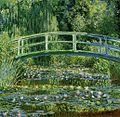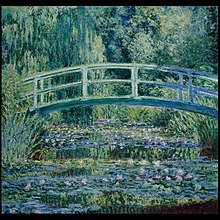Fail:Water-Lilies-and-Japanese-Bridge-(1897-1899)-Monet.jpg

Selle eelvaate suurus: 617 × 599 pikslit. Teised eraldusvõimed: 247 × 240 pikslit | 494 × 480 pikslit | 791 × 768 pikslit | 1031 × 1001 pikslit.
Algfail (1031 × 1001 pikslit, faili suurus: 381 KB, MIME tüüp: image/jpeg)
Faili ajalugu
Klõpsa kuupäeva ja kellaaega, et näha sel ajahetkel kasutusel olnud failiversiooni.
| Kuupäev/kellaaeg | Pisipilt | Mõõtmed | Kasutaja | Kommentaar | |
|---|---|---|---|---|---|
| viimane | 19. jaanuar 2009, kell 23:57 |  | 1031 × 1001 (381 KB) | Krscal | {{Information |Description={{en|1=Water Lilies and Japanese Bridge (1897-1899) by Claude Monet Princeton University Art Museum}} |Source=the-athenaeum.org http://www.the-athenaeum.org/art/full.php?ID=3788 |Author=Claude Monet |Date=1897-1899 |Permission= |
Faili kasutus
Seda faili kasutab järgmine lehekülg:
Globaalne failikasutus
Järgmised muud vikid kasutavad seda faili:
- Faili kasutus vikis ceb.wikipedia.org
- Faili kasutus vikis cs.wikipedia.org
- Faili kasutus vikis cy.wikipedia.org
- Faili kasutus vikis en.wikipedia.org
- Faili kasutus vikis en.wikivoyage.org
- Faili kasutus vikis fr.wikivoyage.org
- Faili kasutus vikis ja.wikipedia.org
- Faili kasutus vikis kbp.wikipedia.org
- Faili kasutus vikis lv.wikipedia.org
- Faili kasutus vikis pl.wikipedia.org
- Faili kasutus vikis pt.wikipedia.org
- Faili kasutus vikis ro.wikipedia.org
- Faili kasutus vikis sl.wikipedia.org
- Faili kasutus vikis sq.wikipedia.org
- Faili kasutus vikis sv.wikipedia.org
- Faili kasutus vikis ta.wikipedia.org
- Faili kasutus vikis vi.wikipedia.org



